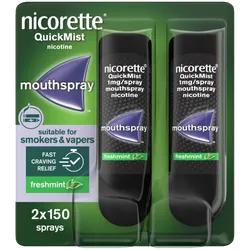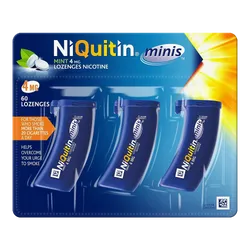Powerful relief to allow you to quickly tackle even your toughest cravings.
NiQuitin Lozenges offer powerful relief and allow you to quickly tackle even your toughest cravings, as and when they happen. They let you control when you get your nicotine. They're easy to keep handy, discreet to use, and come in two flavours - original and mint.
The strength of lozenge you use depends on when you have your first cigarette of the day. If you tend to light up within 30 minutes of waking up, you'll need NiQuitin 4mg Lozenges. If you start more than 30 minutes after waking, you'll need NiQuitin 2mg Lozenges. Then:
- For Step 1, you'll probably need a lozenge every one to two hours, and at least 9 lozenges a day up to a maximum of 15.
- After six weeks you'll be ready to move on to Step 2, and need one lozenge every two to four hours.
- Then after nine weeks, you should be down to one lozenge every four to eight hours.
- Following the step-down programme in this way will let you gradually wean yourself off nicotine so you can quit for good.
2mg is suitable for people who smoke more than 30 minutes after waking up, 4mg is suitable for those who smoke within 30 minutes of waking up.
FAQs
What flavours are available?
Original and mint.
What strength NiQuitin (nicotine) Lozenge should I use?
If you smoke your first cigarette of the day within thirty minutes of waking up, you should use the 4mg Lozenge. If you smoke your first cigarette of the day after you've been awake for 30 minutes or more, use NiQuitin 2mg Lozenges.
For Step 1, you should have a NiQuitin (nicotine) Lozenge every one to two hours. Use at least 9 up to a maximum of 15 lozenges a day. Then, after six weeks, move on to Step 2, and have a lozenge every two to four hours. After nine weeks, you should be down to one NiQuitin (nicotine) Lozenge every four to eight hours.
How do I use the NiQuitin (nicotine) Lozenge?
In order to get the correct dose of therapeutic nicotine from the lozenges, you shouldn't chew them or swallow them whole. Simply place one in your mouth and let it dissolve. Periodically, the lozenge should be moved from one side of your mouth to the other until it's dissolved completely (approximately 20-30 minutes).
Can I eat or drink while using lozenges?
No. Since food and drink can interfere with the nicotine absorption from the lozenge, we recommend you don't.
Can I drink alcohol while I'm on a treatment course of NiQuitin (nicotine) Lozenges?
Yes, you can, but you shouldn't drink either alcoholic or non-alcoholic drinks while you have a lozenge in your mouth. Also, to reduce the risk of a relapse, it's best to avoid drinking alcohol if you associate it with smoking.
What should I do if I smoke while following a treatment course of NiQuitin (nicotine) Lozenges?
If you just smoked a couple but want to continue your quit attempt then you can. If you've gone back to smoking then set a new quit date and try again when you're ready. Or, if you feel that giving up straightaway is too big a step, you can use the lozenges to help you cut down the number of cigarettes you smoke as a first step before stopping completely.
Can I use more than one NiQuitin (nicotine) Lozenge at a time?
No. Each lozenge gives you the right amount of nicotine to tackle your cravings and withdrawal symptoms while the step-down programme slowly weans you off nicotine until you don't need it anymore. During the first 6 weeks of giving up smoking, try to have one NiQuitin (nicotine) Lozenge every one to two hours (use 9-15/day). Then in weeks 7 to 9, have one lozenge every two to four hours, then every four to eight hours in weeks 10 to 12. You should never exceed 15 lozenges per day for either the 2mg or 4mg strength lozenge.
What if I use too many lozenges?
It's very unlikely that you'll overdose, because generally you get less nicotine than when you were smoking. If you do use too many, the effects would be similar to suddenly smoking more cigarettes than you're used to. If you start to feel sick, dizzy and unwell, stop using the NiQuitin (nicotine) Lozenges and get immediate medical advice from a doctor or hospital casualty department. It would be helpful to show them the NiQuitin packet or the leaflet within it.
What happens if a child ingests a lozenge?
Even small quantities of therapeutic nicotine may be dangerous in children and could prove fatal. If you suspect nicotine poisoning in a child, contact your doctor or local hospital immediately. If possible, take the product packaging with you. Be sure to keep NiQuitin (nicotine) Lozenges and any other therapeutic nicotine products in a safe place out of the reach and sight of children.
Signs and symptoms of an overdose include headache, sickness, stomach pains and diarrhoea. If a child has used or eaten any of the lozenges, contact your doctor or nearest hospital casualty department immediately. If possible show them the NiQuitin packet or the leaflet within it.
Can people who smoke roll-ups use NiQuitin (nicotine) Lozenges?
Yes. As with manufactured cigarettes, you can determine what strength NiQuitin (nicotine) Lozenge you should use by how long it is before you smoke your first cigarette of the day. If you have your first cigarette within 30 minutes of waking up, use the 4mg lozenge. If later than 30 minutes, use the lower strength 2mg lozenge. If you think you can stop smoking straightaway then you should. However, if you feel this is too big a step, then you may wish to try cutting down the amount of roll-ups you smoke as a first step before stopping completely.













